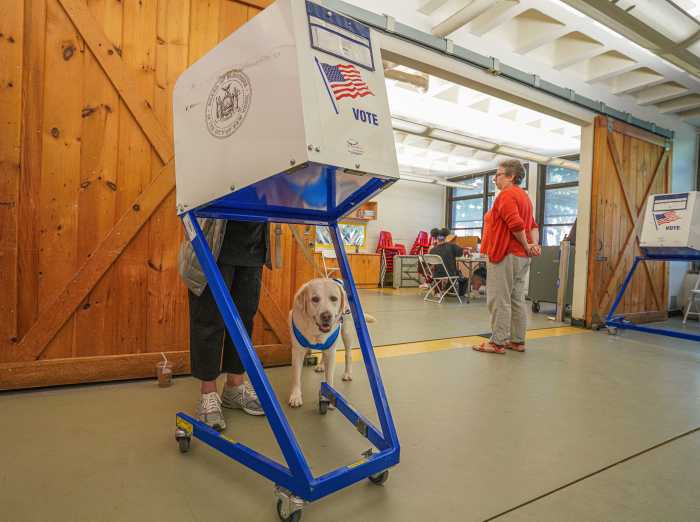Reclining on a blue plastic seat, Uri Katanov stared at the television simulcast of the fifth race at Aqueduct, glancing occasionally at his barbershop just a few feet away. His legs crossed, and surrounded by torn betting slips, Katanov had already lost $20 on the races. His shop - nestled in the back of the track’s grandstand between a closed soup stand and an arcade - was empty.
Even on free admission day at Aqueduct, only two people had stopped in for a haircut; they both worked at the track. Of course, the entire notion of a barbershop at Aqueduct is a bit of a throwback - a time capsule to the time of straw hats, Citation, and of days at the races.
“We used to be able to get 100 people in here on race days,” said Katanov, 73. “Now we get four or three, sometimes no people come at all.”
Dressed in gray slacks, black loafers, a white oxford shirt and a blue barber’s smock, Katanov comes from a family of barbers in Uzbekistan. He said he first cut hair in 1957, and for the past eight years, he staffed the same chair at Aqueduct, snipping and shaving, toiling beneath pictures of horses and hairstyles. There are also two calendars on the painted cinderblock walls - one listing 2008’s race days, the other is a 1987 calendar from the track at Saratoga.
Those were good days, Katanov said, a toothy grin spreading across his face. He turned the barber’s chair to face the TV in the corner of the shop. “This is what we’d do while the race was going,” he said, pretending a customer was in the seat. “We’d stop and watch. Sometimes one of us would win.”
Of the four chairs in the shop, only his is used regularly. An Orthodox Jew, Katanov does not work on Saturdays, so Sal Padavano, 83, and Tony Trotta, 94, fill the void, working only when Katanov is not in the shop. Apparently, it takes an octogenarian and a nonagenarian to do the work of Katanov’s spry fingers. Still, there is not much work to be done.
“Business really slowed down after 9/11,” Katanov said. “After that, I don’t think people wanted to go out to big public places.”
Just a month after 9/11 and only eight miles away from Aqueduct, however, on October 27, 2001, Belmont Park hosted the Breeder’s Cup, and drew 52,987 spectators in the first major international sporting event after the attacks.
According to the New York Racing Association (NYRA), since that race, Belmont has drawn more than 100,000 fans on three separate occasions - the largest crowds in New York history. Each of those races however was the Belmont Stakes - the third leg in racing’s Triple Crown.
Outside of major races, however, attendance is in steep decline across New York’s tracks, down 28 percent from 2001 to 2006. Going back even further, the decline is 55 percent from 1990, when 3.98 million fans clicked through the turnstiles.
“Our real problem is that the industry has told people to not come to the track,” said Fran LaBelle, NYRA’s assistant communications director. “With off-track betting, it’s easy to bet on races from somewhere else now.”
LaBelle pointed out that New York State’s top-five on-track handles - total amounts bet - are all from post-9/11 races, topping out with $14.7 million wagered on the Breeders’ Cup at Belmont on October 29, 2005. “The money and the interest are definitely still there,” he said.
The money exists on a national scale, as well. Although it fell slightly, the total handle on U.S. Thoroughbred races was still $14.7 billion in 2007 - a decrease of 0.4 percent from 2006.
“More people are participating every day now than at any time in the sport’s history,” said Keith Chamblin, senior vice president of the National Thoroughbred Racing Association. “They’re just doing it at thousands of locations across the country instead of the handful they used fifty years ago. We’ve seen a migration from on-track attendance to off-track attendance and simulcast locations around the country.”
Still LaBelle said the vibrancy of the track is gone. “I think what it really comes down to is that the track used to be a whole day out,” he added. “You’d come out with your friends or family, and you’d get your shoes shined, get your hair cut, have a big meal.”
Catering to the notion of a broader race experience, Aqueduct opened what was then the largest restaurant in New York City in 1981. Equestris has seating for 1,600, but with crowd totals for the entire track not much larger than that on most days, the restaurant, which has a dress code, is more a cavernous relic than an achievement to be touted.
Fans instead congregate around the Nathan’s hot dog stand and the Sbarro pizza restaurant in the food court. They grab their pizza and hot dogs and scamper back to the TVs or to the track itself. Few even notice the barbershop.
“I didn’t even know they did that,” said Steve Borger, 47, whose unruly white mane needed a trim. “I guess it’s good that they cut hair here, but I’ve already got a guy. Plus, I’m here for the races.”
Leaning on his barber’s chair, Katanov looked out at the bettors through the shop’s floor-to-ceiling windows. He seemed pensive, as though he were trying to recall something. Then he stood up and started to move toward the door.
“I’m going to play,” he said, his smile back. “The last guy in here gave me a tip that seven doesn’t lose. Maybe I’ll get lucky.”
Seven lost.

































